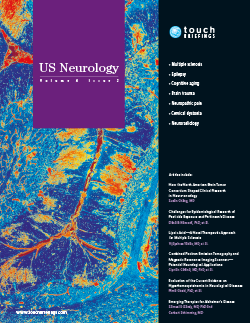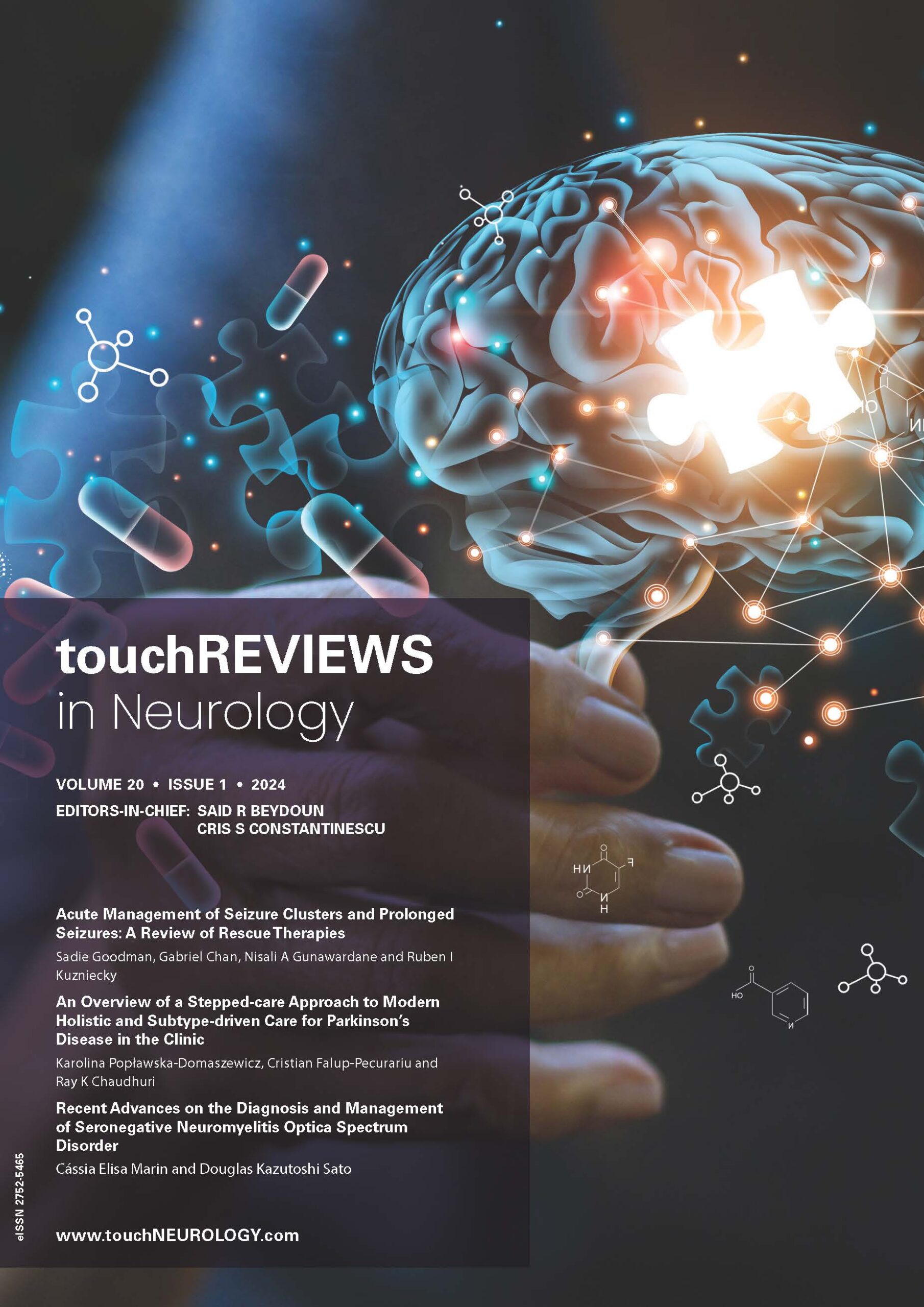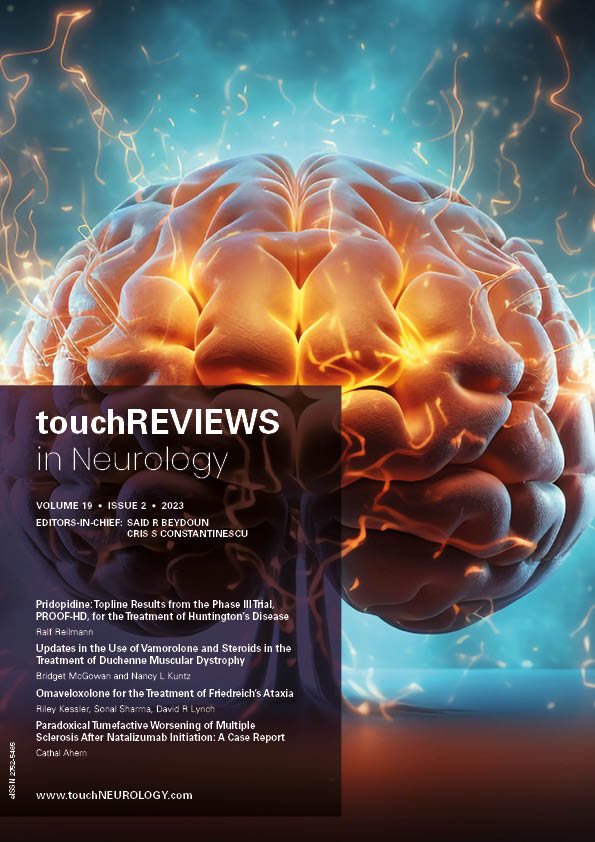
US NEUROLOGY – VOLUME 4 ISSUE 2 – FALL 2008
Advisory Panel
In addition to the panel members below, Touch Briefings would like to thank Robert M Friedlander, MD Vice Chairman, Department of Neurosurgery Research, Brigham and Women’s Hospital/Harvard Medical School William Friedman, MD, PhD Rhoton Professor, and Chairman, Department of Neurosurgery, University of Florida Vincent Gattullo President, American Parkinson’s Disease Association (APDA)
Foreword
Advances in neuroimaging, neurophysiology, molecular biology, and genetics have given us the opportunity to examine the nervous system in ways that were previously unimaginable. This has led to greater insight into the nature of neurological disease, enhanced diagnostic capacities, and provided new opportunities for our patients. This has also, however, led to a vast amount […]
Current Issues
Homocysteine – A Marker for Vitamin Deficiency and a Risk Factor for Neurological Diseases
Multiple Sclerosis
Until 1993 there were no US Food and Drug Administration (FDA)- approved drugs for MS. Recombinant interferon beta 1b (Betaseron®) became the first disease-modifying treatment available for the illness. Since then, five other FDA-approved drugs have become available for MS treatment. These include two forms of recombinant interferon beta 1a (Avonex®, Rebif®), glatiramer acetate (Copaxone®), […]
Quality care of people living with chronic diseases such as multiple sclerosis (MS) means treating the patient holistically with all beneficial interventions, whether medical, surgical, behavioral, or spiritual. Everyone involved in healthcare is responsible for encouraging patients to adhere to therapies that may improve or sustain their health and quality of life. For this reason, […]
Brain Trauma
The Cerebral Stroke Center at Wakakusa Daiichi Hospital in Japan used computed tomography perfusion (CTP) for selecting candidates for catheter thrombolysis therapy from June 2002 to June 2005, until the treatment guidelines, which were for thrombolysis therapy by intravenous administration of recombinant tissue-type plasminogen activator (alteplase) for hyper-acute cerebral stroke patients, were established by the […]
The Importance of Treating Stroke
Although benign in nature, pituitary tumors continue to offer many opportunities for improvement in therapy. Goals of treatment include complete removal or ablation of tumor cells, maintenance of normal pituitary function, normalization of elevated hormone levels in endocrine-active tumors, and minimizing adverse effects from therapy. There have been many recent advances related to the surgical […]
More than 700,000 acute strokes1 and 300,000 transient ischemic attacks (TIAs)2,3 occur annually in the US. It is estimated that between 15 and 26% of acute stroke cases have a prior history of TIA.4 TIAs are important because they are associated with high short-term risk for both stroke and cardiac events. In a widely quoted […]
The North American Brain Tumor Consortium (NABTC) is one of three multi-institutional consortia initially funded by the National Cancer Institute (NCI) in 1994 with the primary purpose of efficiently evaluating novel treatments in adults with central nervous system (CNS) tumors. Its current counterpart is New Approaches to Brain Tumor Therapy (NABTT) and although the consortia […]
Despite significant advances in tumor imaging, neurosurgery, and radiotherapy, the prognosis for patients with malignant gliomas is extremely poor. The five-year survival rate for patients with glioblastoma (GBM), the most aggressive form of malignant glioma, is less than 5% after initial diagnosis.1 Factors that contribute to the dismal prognosis associated with GBM include its infiltrative […]
Cognitive Aging
Parkinson’s disease (PD) is a devastating, progressive disorder that responds favorably to therapeutic doses of levodopa, its gold standard therapy. The phase of the disease (early, middle, or advanced) largely determines the type of treatment. Initially, there is good response to medication and adjuvant therapeutic strategies but, after several years, motor and non-motor complications develop. […]
Parkinson’s disease (PD), a neurodegenerative disease affecting at least one million individuals in the US, is characterized by a progressive loss of dopaminergic neurons in the substantia nigra and the formation of Lewy bodies (inclusions composed of aggregated proteins) in the surviving neurons. Once approximately 70% of the dopaminergic neurons have been lost, the clinical […]
Complement activation is a major inflammatory process whose primary functions are to assist in removing micro-organisms and cellular debris and processing of immune complexes. The complement system is composed of more than 30 plasma and membrane-associated proteins, accounting for approximately 10% of the globulins in vertebrate serum, which function as an inflammatory cascade. Complement can […]
There is consensus among researchers that the biological basis of Alzheimer’s disease (AD) lies in the abnormal accumulation of toxic amyloid protein in the brain.1,2 In brief, the amyloid hypothesis of AD states that the amyloid precursor protein (APP), encoded on chromosome 21 and ubiquitously expressed as a glycosylated transmembrane protein, is abnormally cleaved into […]
Cervical Dystonia
Diagnosis of Cervical Dystonia
Epilepsy
The accurate diagnosis of epilepsy is difficult. Studies in tertiary epilepsy centers have shown that 30% of adult patients referred for intractable ‘epilepsy’ have non-epileptic events, chiefly psychogenic non-epileptic spells (PNES).1 Likewise, in pediatric epilepsy centers, 15–39% have non-epileptic paroxysmal events.2,3 The electroencephalogram (EEG) can be both helpful and misleading in diagnosis. In children, up […]
The aim of abating seizures in a spatio-temporally selective manner is not a modern one. As early as 150 AD, Pelops from Alexandria, the teacher of Galen, was reported to have aborted what would likely be referred to today as ‘a simple partial seizure with sensory-motor manifestations’ by tying a ligature around the affected limb […]
Neuropathic Pain
Management of neuropathic pain is a real clinical challenge. Current treatments focus on blocking neurotransmission and do not differentiate between different phases of neuropathic pain pathophysiology. The authors have recently shown that nerve-injury-induced neuropathic pain development requires matrix metalloprotease-9 and -2 (MMP-9 and MMP- 2) in the early and late phase, respectively. Inhibition of MMP-9 […]
Neuroradiology
Recently, there has been great interest in combining positron emission tomography (PET) and magnetic resonance imaging (MRI), and a number of integrated scanners capable of simultaneous acquisition have been developed and successfully tested in small animal1,2 and human3 imaging. These efforts are broad enough to deserve their own review, something beyond our scope here. Instead, […]

Trending Topic
Seizures are one of the most frequent neurological disorders in neonates − the incidence of seizures in infants born at term is 1–3 per 1,000 live births, and is even higher in both preterm and very-low-birth-weight infants at 1–13 per 1,000 live births.1 Seizures may signify serious malfunction of, or damage to, the immature brain and […]
Journal Archive
touchREVIEWS in Neurology is a peer-reviewed, free-to-access, bi-annual neurology journal comprising review articles, case reports, practice guides, theoretical discussions, and original research. It features balanced and comprehensive articles written by leading authorities, addressing the most important and salient developments in the field of neurology.
Latest articles videos and clinical updates - straight to your inbox
Log into your Touch Account
Earn and track your CME credits on the go, save articles for later, and follow the latest congress coverage.
Register now for FREE Access
Register for free to hear about the latest expert-led education, peer-reviewed articles, conference highlights, and innovative CME activities.
Sign up with an Email
Or use a Social Account.
This Functionality is for
Members Only
Explore the latest in medical education and stay current in your field. Create a free account to track your learning.





